Essay on Enterprise Resource Planning (ERP) Systems and Their Benefits
VerifiedAdded on 2020/10/05
|10
|2774
|198
Essay
AI Summary
This essay provides a comprehensive overview of Enterprise Resource Planning (ERP) systems. It begins by defining ERP and its role in managing business processes, emphasizing its ability to automate back-office functions. The essay then delves into various categories of information systems, including Transaction Processing Systems (TPS), Decision Support Systems (DSS), Management Information Systems (MIS), Online Analytical Processing (OLAP), and Artificial Intelligence (AI) techniques, explaining their functions and applications within a business context. The core of the essay focuses on ERP systems, detailing various types of ERP software like Sage Intacct, SYSPRO, Oracle ERP cloud, Microsoft Dynamics GP, and ADVANTAGE 365, and their respective features and capabilities. The essay also outlines the benefits of ERP systems, such as improved efficiency, complete workflow visibility, enhanced planning and reporting, data security and quality, standardization of business processes, facilitation of regulatory compliance, and improved supply chain management. The conclusion reiterates the importance of information systems and ERP in streamlining business operations, increasing productivity, and reducing errors. This essay underscores the significance of ERP as an essential tool for modern business management, and provides practical insights into its implementation and advantages.
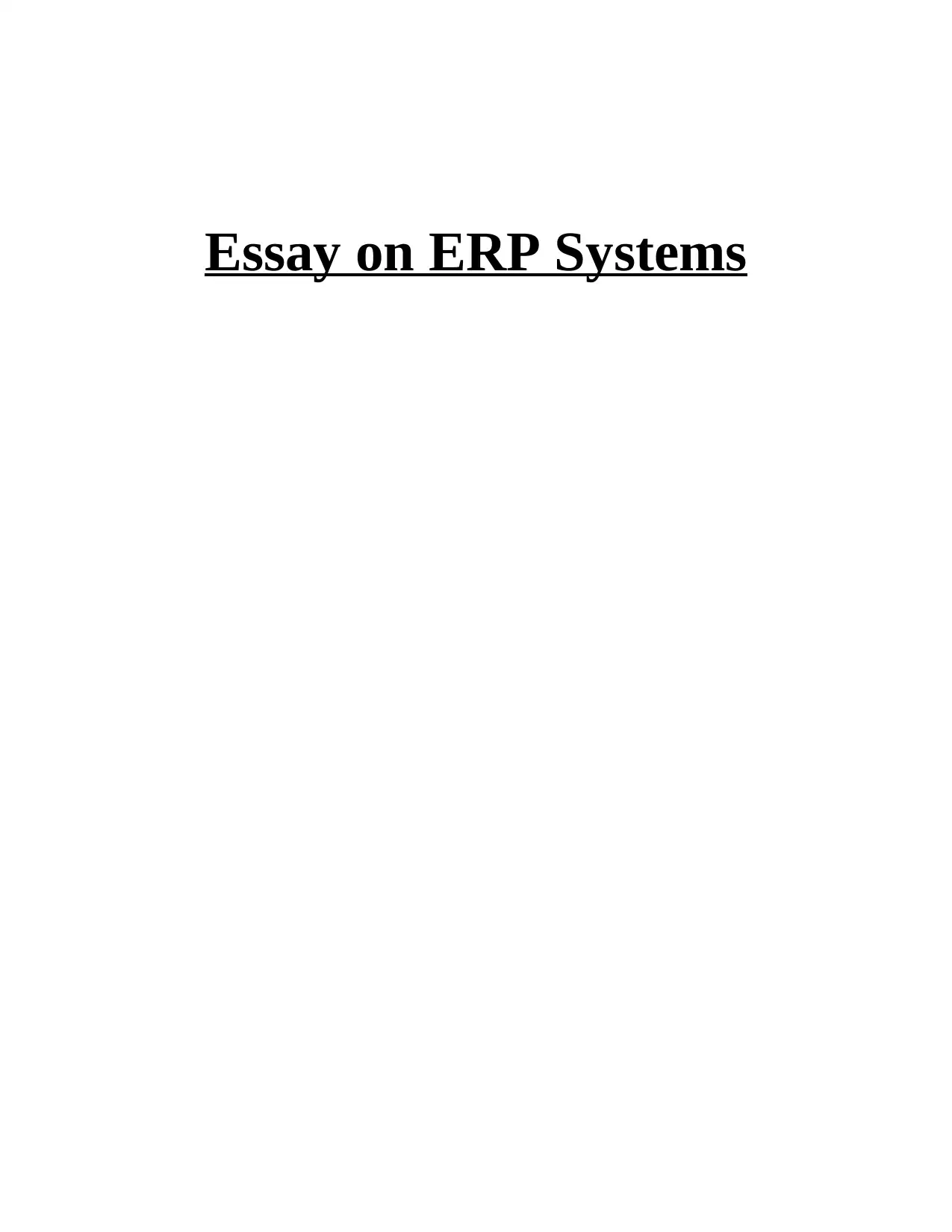
Essay on ERP Systems
Paraphrase This Document
Need a fresh take? Get an instant paraphrase of this document with our AI Paraphraser
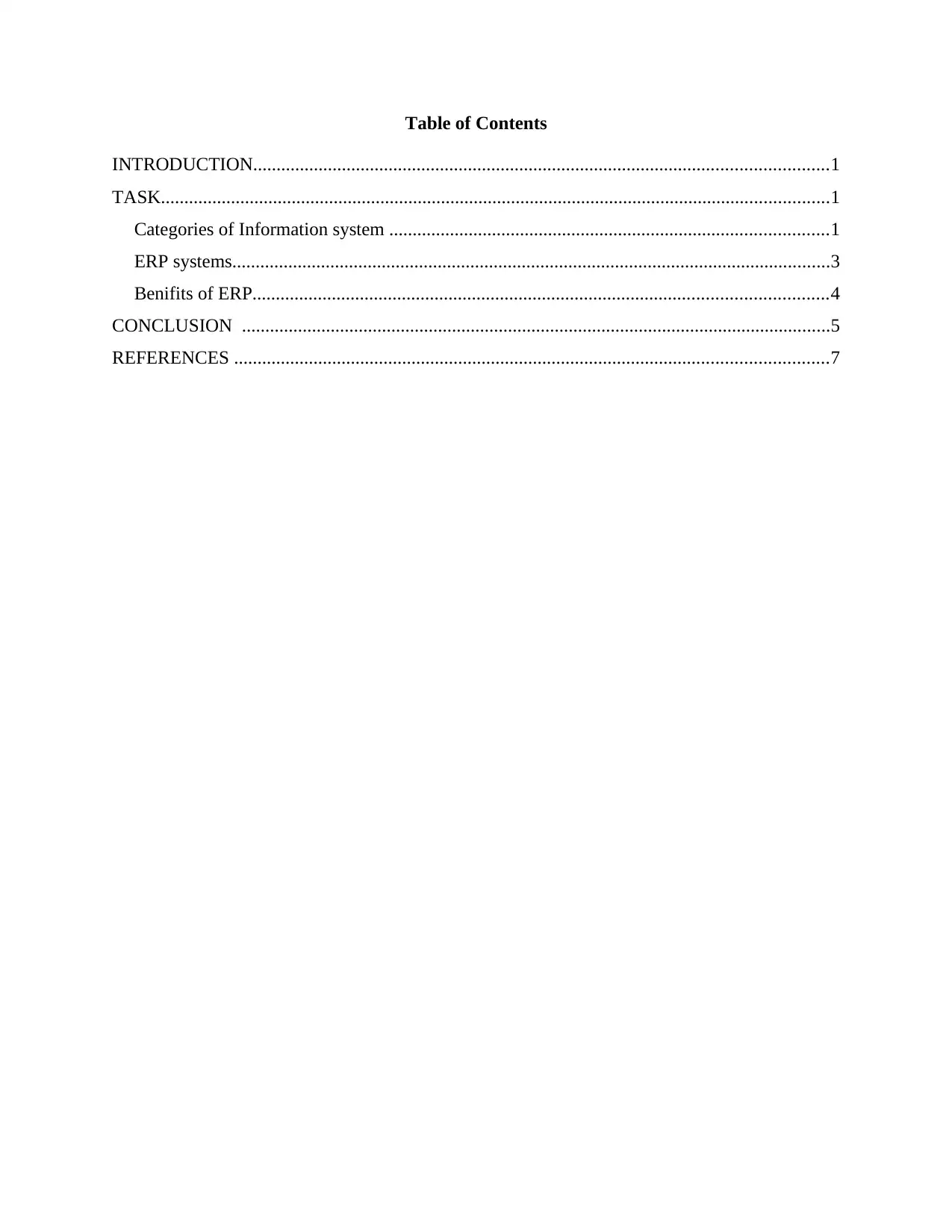
Table of Contents
INTRODUCTION...........................................................................................................................1
TASK...............................................................................................................................................1
Categories of Information system ..............................................................................................1
ERP systems................................................................................................................................3
Benifits of ERP...........................................................................................................................4
CONCLUSION ..............................................................................................................................5
REFERENCES ...............................................................................................................................7
INTRODUCTION...........................................................................................................................1
TASK...............................................................................................................................................1
Categories of Information system ..............................................................................................1
ERP systems................................................................................................................................3
Benifits of ERP...........................................................................................................................4
CONCLUSION ..............................................................................................................................5
REFERENCES ...............................................................................................................................7
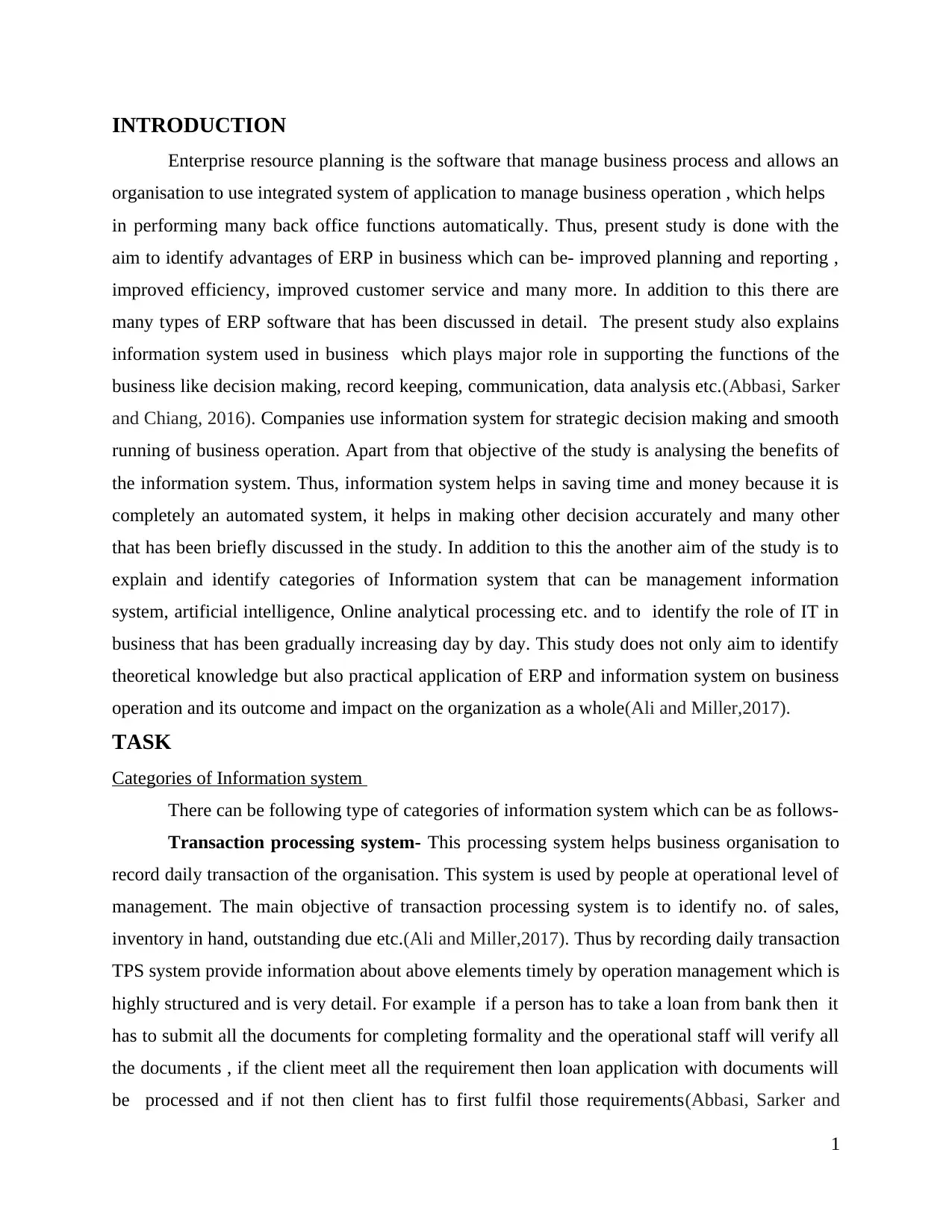
INTRODUCTION
Enterprise resource planning is the software that manage business process and allows an
organisation to use integrated system of application to manage business operation , which helps
in performing many back office functions automatically. Thus, present study is done with the
aim to identify advantages of ERP in business which can be- improved planning and reporting ,
improved efficiency, improved customer service and many more. In addition to this there are
many types of ERP software that has been discussed in detail. The present study also explains
information system used in business which plays major role in supporting the functions of the
business like decision making, record keeping, communication, data analysis etc.(Abbasi, Sarker
and Chiang, 2016). Companies use information system for strategic decision making and smooth
running of business operation. Apart from that objective of the study is analysing the benefits of
the information system. Thus, information system helps in saving time and money because it is
completely an automated system, it helps in making other decision accurately and many other
that has been briefly discussed in the study. In addition to this the another aim of the study is to
explain and identify categories of Information system that can be management information
system, artificial intelligence, Online analytical processing etc. and to identify the role of IT in
business that has been gradually increasing day by day. This study does not only aim to identify
theoretical knowledge but also practical application of ERP and information system on business
operation and its outcome and impact on the organization as a whole(Ali and Miller,2017).
TASK
Categories of Information system
There can be following type of categories of information system which can be as follows-
Transaction processing system- This processing system helps business organisation to
record daily transaction of the organisation. This system is used by people at operational level of
management. The main objective of transaction processing system is to identify no. of sales,
inventory in hand, outstanding due etc.(Ali and Miller,2017). Thus by recording daily transaction
TPS system provide information about above elements timely by operation management which is
highly structured and is very detail. For example if a person has to take a loan from bank then it
has to submit all the documents for completing formality and the operational staff will verify all
the documents , if the client meet all the requirement then loan application with documents will
be processed and if not then client has to first fulfil those requirements(Abbasi, Sarker and
1
Enterprise resource planning is the software that manage business process and allows an
organisation to use integrated system of application to manage business operation , which helps
in performing many back office functions automatically. Thus, present study is done with the
aim to identify advantages of ERP in business which can be- improved planning and reporting ,
improved efficiency, improved customer service and many more. In addition to this there are
many types of ERP software that has been discussed in detail. The present study also explains
information system used in business which plays major role in supporting the functions of the
business like decision making, record keeping, communication, data analysis etc.(Abbasi, Sarker
and Chiang, 2016). Companies use information system for strategic decision making and smooth
running of business operation. Apart from that objective of the study is analysing the benefits of
the information system. Thus, information system helps in saving time and money because it is
completely an automated system, it helps in making other decision accurately and many other
that has been briefly discussed in the study. In addition to this the another aim of the study is to
explain and identify categories of Information system that can be management information
system, artificial intelligence, Online analytical processing etc. and to identify the role of IT in
business that has been gradually increasing day by day. This study does not only aim to identify
theoretical knowledge but also practical application of ERP and information system on business
operation and its outcome and impact on the organization as a whole(Ali and Miller,2017).
TASK
Categories of Information system
There can be following type of categories of information system which can be as follows-
Transaction processing system- This processing system helps business organisation to
record daily transaction of the organisation. This system is used by people at operational level of
management. The main objective of transaction processing system is to identify no. of sales,
inventory in hand, outstanding due etc.(Ali and Miller,2017). Thus by recording daily transaction
TPS system provide information about above elements timely by operation management which is
highly structured and is very detail. For example if a person has to take a loan from bank then it
has to submit all the documents for completing formality and the operational staff will verify all
the documents , if the client meet all the requirement then loan application with documents will
be processed and if not then client has to first fulfil those requirements(Abbasi, Sarker and
1
⊘ This is a preview!⊘
Do you want full access?
Subscribe today to unlock all pages.

Trusted by 1+ million students worldwide
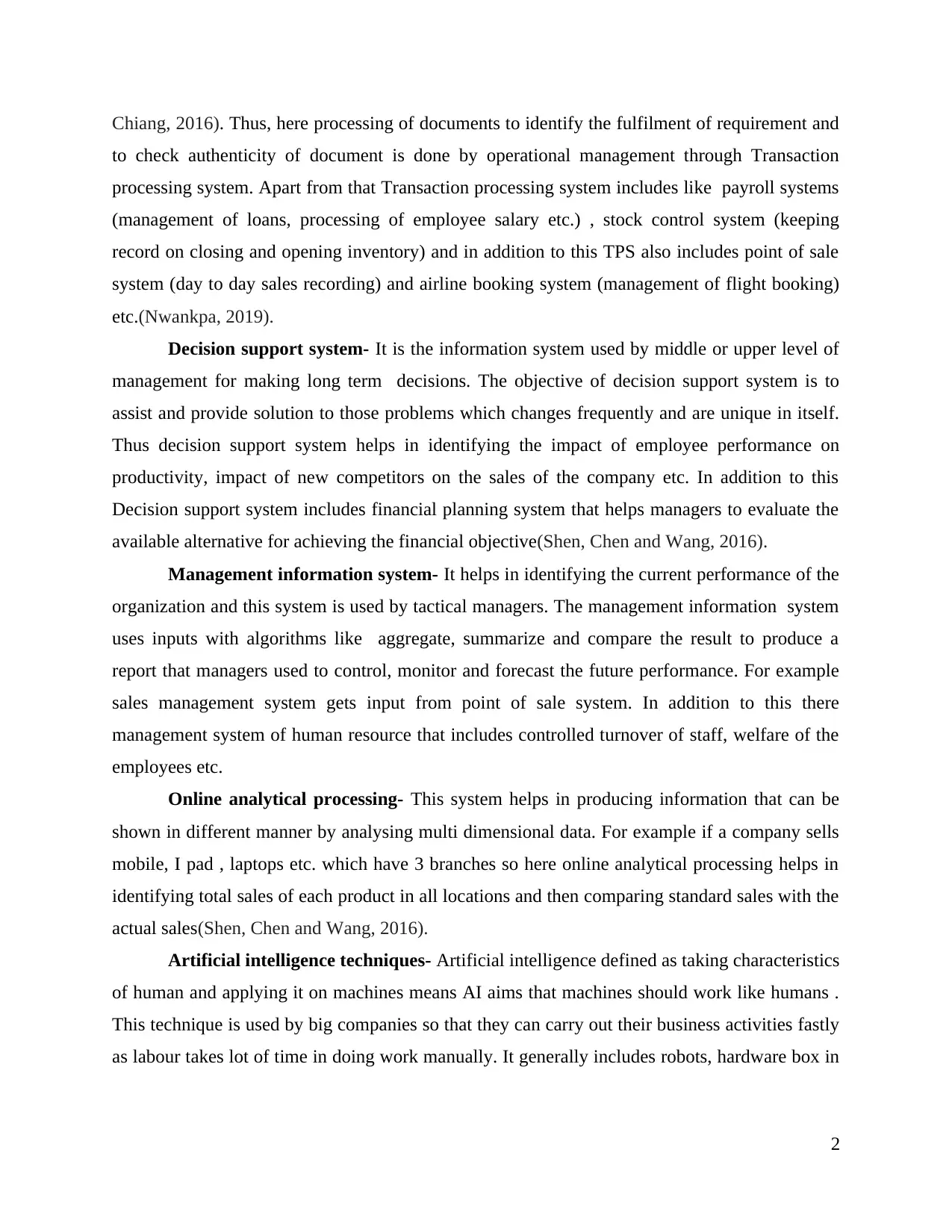
Chiang, 2016). Thus, here processing of documents to identify the fulfilment of requirement and
to check authenticity of document is done by operational management through Transaction
processing system. Apart from that Transaction processing system includes like payroll systems
(management of loans, processing of employee salary etc.) , stock control system (keeping
record on closing and opening inventory) and in addition to this TPS also includes point of sale
system (day to day sales recording) and airline booking system (management of flight booking)
etc.(Nwankpa, 2019).
Decision support system- It is the information system used by middle or upper level of
management for making long term decisions. The objective of decision support system is to
assist and provide solution to those problems which changes frequently and are unique in itself.
Thus decision support system helps in identifying the impact of employee performance on
productivity, impact of new competitors on the sales of the company etc. In addition to this
Decision support system includes financial planning system that helps managers to evaluate the
available alternative for achieving the financial objective(Shen, Chen and Wang, 2016).
Management information system- It helps in identifying the current performance of the
organization and this system is used by tactical managers. The management information system
uses inputs with algorithms like aggregate, summarize and compare the result to produce a
report that managers used to control, monitor and forecast the future performance. For example
sales management system gets input from point of sale system. In addition to this there
management system of human resource that includes controlled turnover of staff, welfare of the
employees etc.
Online analytical processing- This system helps in producing information that can be
shown in different manner by analysing multi dimensional data. For example if a company sells
mobile, I pad , laptops etc. which have 3 branches so here online analytical processing helps in
identifying total sales of each product in all locations and then comparing standard sales with the
actual sales(Shen, Chen and Wang, 2016).
Artificial intelligence techniques- Artificial intelligence defined as taking characteristics
of human and applying it on machines means AI aims that machines should work like humans .
This technique is used by big companies so that they can carry out their business activities fastly
as labour takes lot of time in doing work manually. It generally includes robots, hardware box in
2
to check authenticity of document is done by operational management through Transaction
processing system. Apart from that Transaction processing system includes like payroll systems
(management of loans, processing of employee salary etc.) , stock control system (keeping
record on closing and opening inventory) and in addition to this TPS also includes point of sale
system (day to day sales recording) and airline booking system (management of flight booking)
etc.(Nwankpa, 2019).
Decision support system- It is the information system used by middle or upper level of
management for making long term decisions. The objective of decision support system is to
assist and provide solution to those problems which changes frequently and are unique in itself.
Thus decision support system helps in identifying the impact of employee performance on
productivity, impact of new competitors on the sales of the company etc. In addition to this
Decision support system includes financial planning system that helps managers to evaluate the
available alternative for achieving the financial objective(Shen, Chen and Wang, 2016).
Management information system- It helps in identifying the current performance of the
organization and this system is used by tactical managers. The management information system
uses inputs with algorithms like aggregate, summarize and compare the result to produce a
report that managers used to control, monitor and forecast the future performance. For example
sales management system gets input from point of sale system. In addition to this there
management system of human resource that includes controlled turnover of staff, welfare of the
employees etc.
Online analytical processing- This system helps in producing information that can be
shown in different manner by analysing multi dimensional data. For example if a company sells
mobile, I pad , laptops etc. which have 3 branches so here online analytical processing helps in
identifying total sales of each product in all locations and then comparing standard sales with the
actual sales(Shen, Chen and Wang, 2016).
Artificial intelligence techniques- Artificial intelligence defined as taking characteristics
of human and applying it on machines means AI aims that machines should work like humans .
This technique is used by big companies so that they can carry out their business activities fastly
as labour takes lot of time in doing work manually. It generally includes robots, hardware box in
2
Paraphrase This Document
Need a fresh take? Get an instant paraphrase of this document with our AI Paraphraser
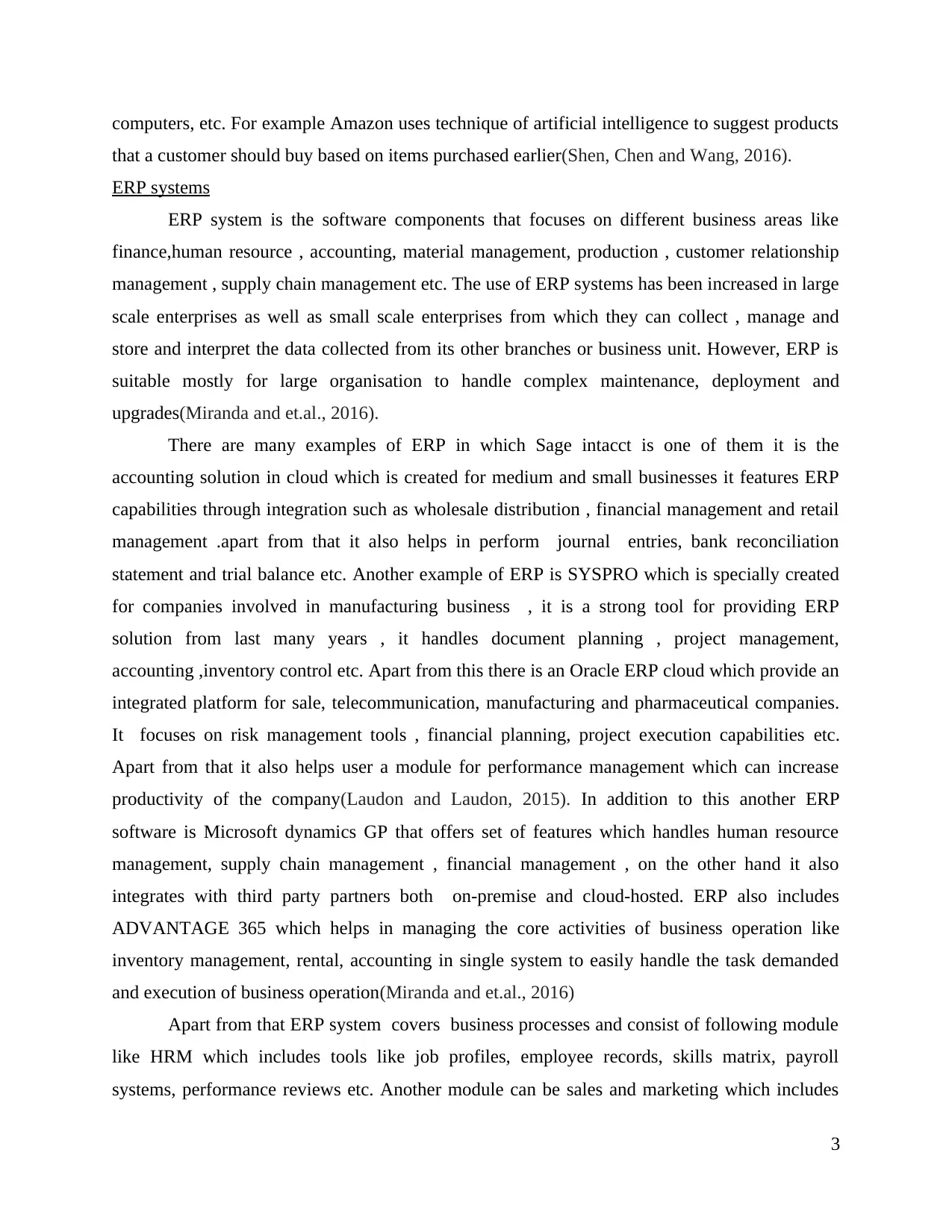
computers, etc. For example Amazon uses technique of artificial intelligence to suggest products
that a customer should buy based on items purchased earlier(Shen, Chen and Wang, 2016).
ERP systems
ERP system is the software components that focuses on different business areas like
finance,human resource , accounting, material management, production , customer relationship
management , supply chain management etc. The use of ERP systems has been increased in large
scale enterprises as well as small scale enterprises from which they can collect , manage and
store and interpret the data collected from its other branches or business unit. However, ERP is
suitable mostly for large organisation to handle complex maintenance, deployment and
upgrades(Miranda and et.al., 2016).
There are many examples of ERP in which Sage intacct is one of them it is the
accounting solution in cloud which is created for medium and small businesses it features ERP
capabilities through integration such as wholesale distribution , financial management and retail
management .apart from that it also helps in perform journal entries, bank reconciliation
statement and trial balance etc. Another example of ERP is SYSPRO which is specially created
for companies involved in manufacturing business , it is a strong tool for providing ERP
solution from last many years , it handles document planning , project management,
accounting ,inventory control etc. Apart from this there is an Oracle ERP cloud which provide an
integrated platform for sale, telecommunication, manufacturing and pharmaceutical companies.
It focuses on risk management tools , financial planning, project execution capabilities etc.
Apart from that it also helps user a module for performance management which can increase
productivity of the company(Laudon and Laudon, 2015). In addition to this another ERP
software is Microsoft dynamics GP that offers set of features which handles human resource
management, supply chain management , financial management , on the other hand it also
integrates with third party partners both on-premise and cloud-hosted. ERP also includes
ADVANTAGE 365 which helps in managing the core activities of business operation like
inventory management, rental, accounting in single system to easily handle the task demanded
and execution of business operation(Miranda and et.al., 2016)
Apart from that ERP system covers business processes and consist of following module
like HRM which includes tools like job profiles, employee records, skills matrix, payroll
systems, performance reviews etc. Another module can be sales and marketing which includes
3
that a customer should buy based on items purchased earlier(Shen, Chen and Wang, 2016).
ERP systems
ERP system is the software components that focuses on different business areas like
finance,human resource , accounting, material management, production , customer relationship
management , supply chain management etc. The use of ERP systems has been increased in large
scale enterprises as well as small scale enterprises from which they can collect , manage and
store and interpret the data collected from its other branches or business unit. However, ERP is
suitable mostly for large organisation to handle complex maintenance, deployment and
upgrades(Miranda and et.al., 2016).
There are many examples of ERP in which Sage intacct is one of them it is the
accounting solution in cloud which is created for medium and small businesses it features ERP
capabilities through integration such as wholesale distribution , financial management and retail
management .apart from that it also helps in perform journal entries, bank reconciliation
statement and trial balance etc. Another example of ERP is SYSPRO which is specially created
for companies involved in manufacturing business , it is a strong tool for providing ERP
solution from last many years , it handles document planning , project management,
accounting ,inventory control etc. Apart from this there is an Oracle ERP cloud which provide an
integrated platform for sale, telecommunication, manufacturing and pharmaceutical companies.
It focuses on risk management tools , financial planning, project execution capabilities etc.
Apart from that it also helps user a module for performance management which can increase
productivity of the company(Laudon and Laudon, 2015). In addition to this another ERP
software is Microsoft dynamics GP that offers set of features which handles human resource
management, supply chain management , financial management , on the other hand it also
integrates with third party partners both on-premise and cloud-hosted. ERP also includes
ADVANTAGE 365 which helps in managing the core activities of business operation like
inventory management, rental, accounting in single system to easily handle the task demanded
and execution of business operation(Miranda and et.al., 2016)
Apart from that ERP system covers business processes and consist of following module
like HRM which includes tools like job profiles, employee records, skills matrix, payroll
systems, performance reviews etc. Another module can be sales and marketing which includes
3
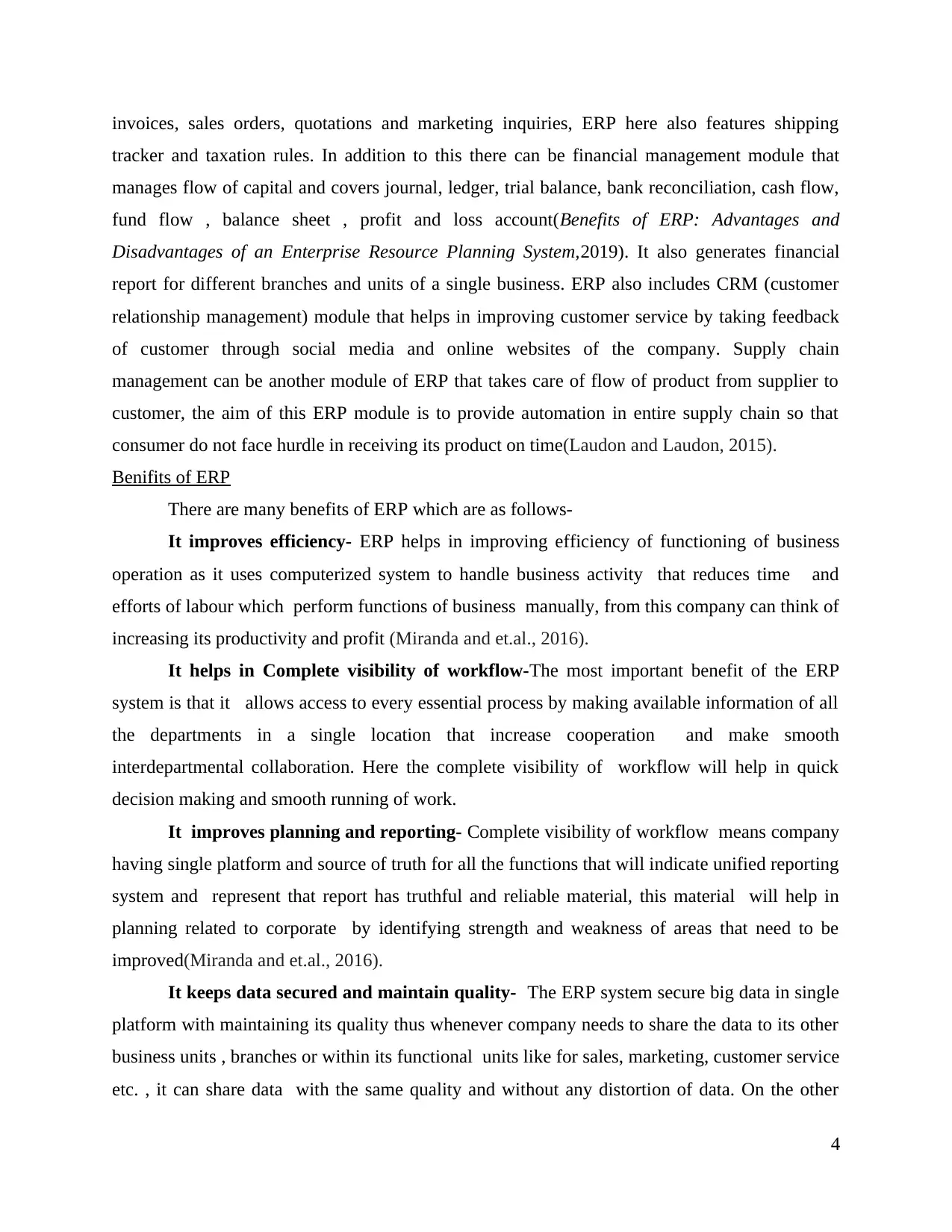
invoices, sales orders, quotations and marketing inquiries, ERP here also features shipping
tracker and taxation rules. In addition to this there can be financial management module that
manages flow of capital and covers journal, ledger, trial balance, bank reconciliation, cash flow,
fund flow , balance sheet , profit and loss account(Benefits of ERP: Advantages and
Disadvantages of an Enterprise Resource Planning System,2019). It also generates financial
report for different branches and units of a single business. ERP also includes CRM (customer
relationship management) module that helps in improving customer service by taking feedback
of customer through social media and online websites of the company. Supply chain
management can be another module of ERP that takes care of flow of product from supplier to
customer, the aim of this ERP module is to provide automation in entire supply chain so that
consumer do not face hurdle in receiving its product on time(Laudon and Laudon, 2015).
Benifits of ERP
There are many benefits of ERP which are as follows-
It improves efficiency- ERP helps in improving efficiency of functioning of business
operation as it uses computerized system to handle business activity that reduces time and
efforts of labour which perform functions of business manually, from this company can think of
increasing its productivity and profit (Miranda and et.al., 2016).
It helps in Complete visibility of workflow-The most important benefit of the ERP
system is that it allows access to every essential process by making available information of all
the departments in a single location that increase cooperation and make smooth
interdepartmental collaboration. Here the complete visibility of workflow will help in quick
decision making and smooth running of work.
It improves planning and reporting- Complete visibility of workflow means company
having single platform and source of truth for all the functions that will indicate unified reporting
system and represent that report has truthful and reliable material, this material will help in
planning related to corporate by identifying strength and weakness of areas that need to be
improved(Miranda and et.al., 2016).
It keeps data secured and maintain quality- The ERP system secure big data in single
platform with maintaining its quality thus whenever company needs to share the data to its other
business units , branches or within its functional units like for sales, marketing, customer service
etc. , it can share data with the same quality and without any distortion of data. On the other
4
tracker and taxation rules. In addition to this there can be financial management module that
manages flow of capital and covers journal, ledger, trial balance, bank reconciliation, cash flow,
fund flow , balance sheet , profit and loss account(Benefits of ERP: Advantages and
Disadvantages of an Enterprise Resource Planning System,2019). It also generates financial
report for different branches and units of a single business. ERP also includes CRM (customer
relationship management) module that helps in improving customer service by taking feedback
of customer through social media and online websites of the company. Supply chain
management can be another module of ERP that takes care of flow of product from supplier to
customer, the aim of this ERP module is to provide automation in entire supply chain so that
consumer do not face hurdle in receiving its product on time(Laudon and Laudon, 2015).
Benifits of ERP
There are many benefits of ERP which are as follows-
It improves efficiency- ERP helps in improving efficiency of functioning of business
operation as it uses computerized system to handle business activity that reduces time and
efforts of labour which perform functions of business manually, from this company can think of
increasing its productivity and profit (Miranda and et.al., 2016).
It helps in Complete visibility of workflow-The most important benefit of the ERP
system is that it allows access to every essential process by making available information of all
the departments in a single location that increase cooperation and make smooth
interdepartmental collaboration. Here the complete visibility of workflow will help in quick
decision making and smooth running of work.
It improves planning and reporting- Complete visibility of workflow means company
having single platform and source of truth for all the functions that will indicate unified reporting
system and represent that report has truthful and reliable material, this material will help in
planning related to corporate by identifying strength and weakness of areas that need to be
improved(Miranda and et.al., 2016).
It keeps data secured and maintain quality- The ERP system secure big data in single
platform with maintaining its quality thus whenever company needs to share the data to its other
business units , branches or within its functional units like for sales, marketing, customer service
etc. , it can share data with the same quality and without any distortion of data. On the other
4
⊘ This is a preview!⊘
Do you want full access?
Subscribe today to unlock all pages.

Trusted by 1+ million students worldwide
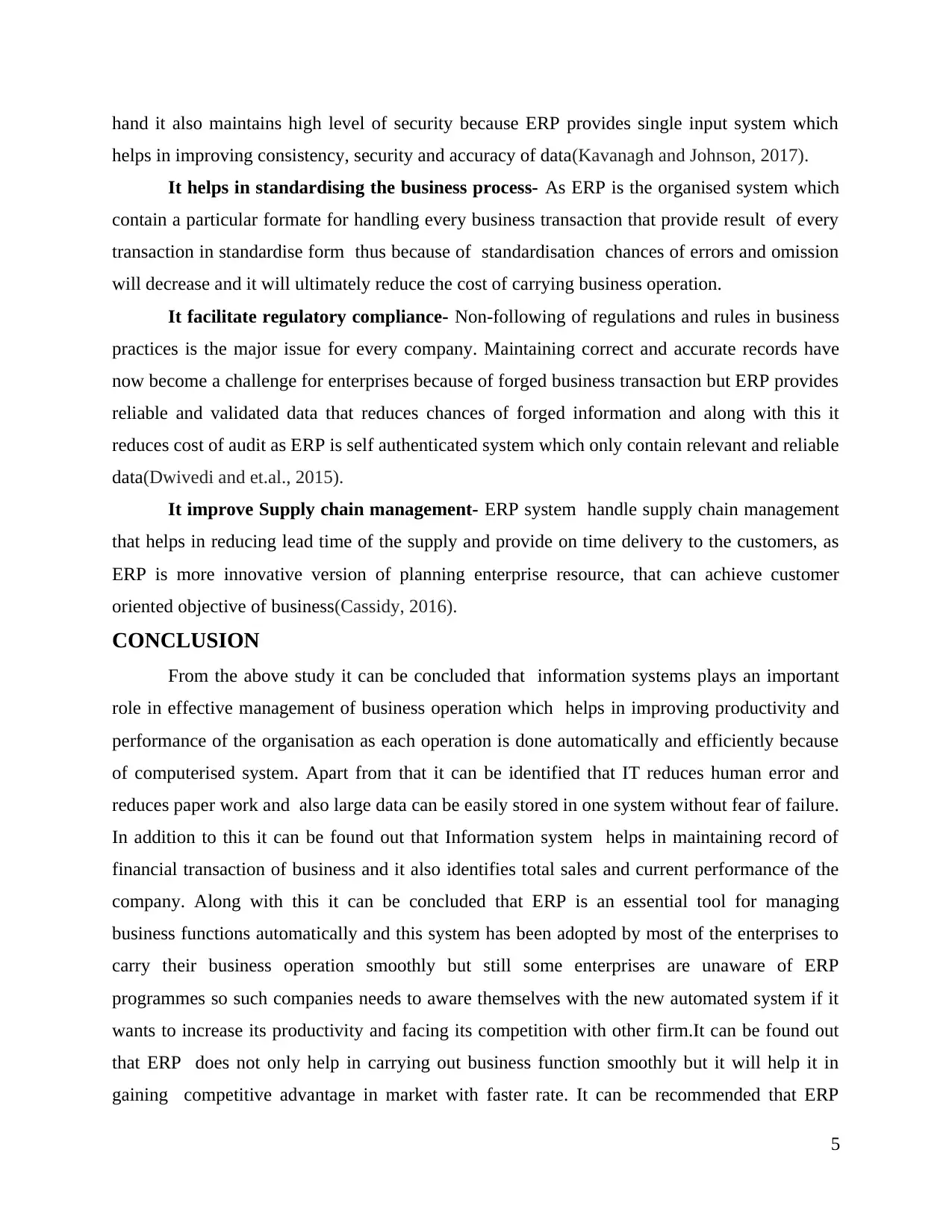
hand it also maintains high level of security because ERP provides single input system which
helps in improving consistency, security and accuracy of data(Kavanagh and Johnson, 2017).
It helps in standardising the business process- As ERP is the organised system which
contain a particular formate for handling every business transaction that provide result of every
transaction in standardise form thus because of standardisation chances of errors and omission
will decrease and it will ultimately reduce the cost of carrying business operation.
It facilitate regulatory compliance- Non-following of regulations and rules in business
practices is the major issue for every company. Maintaining correct and accurate records have
now become a challenge for enterprises because of forged business transaction but ERP provides
reliable and validated data that reduces chances of forged information and along with this it
reduces cost of audit as ERP is self authenticated system which only contain relevant and reliable
data(Dwivedi and et.al., 2015).
It improve Supply chain management- ERP system handle supply chain management
that helps in reducing lead time of the supply and provide on time delivery to the customers, as
ERP is more innovative version of planning enterprise resource, that can achieve customer
oriented objective of business(Cassidy, 2016).
CONCLUSION
From the above study it can be concluded that information systems plays an important
role in effective management of business operation which helps in improving productivity and
performance of the organisation as each operation is done automatically and efficiently because
of computerised system. Apart from that it can be identified that IT reduces human error and
reduces paper work and also large data can be easily stored in one system without fear of failure.
In addition to this it can be found out that Information system helps in maintaining record of
financial transaction of business and it also identifies total sales and current performance of the
company. Along with this it can be concluded that ERP is an essential tool for managing
business functions automatically and this system has been adopted by most of the enterprises to
carry their business operation smoothly but still some enterprises are unaware of ERP
programmes so such companies needs to aware themselves with the new automated system if it
wants to increase its productivity and facing its competition with other firm.It can be found out
that ERP does not only help in carrying out business function smoothly but it will help it in
gaining competitive advantage in market with faster rate. It can be recommended that ERP
5
helps in improving consistency, security and accuracy of data(Kavanagh and Johnson, 2017).
It helps in standardising the business process- As ERP is the organised system which
contain a particular formate for handling every business transaction that provide result of every
transaction in standardise form thus because of standardisation chances of errors and omission
will decrease and it will ultimately reduce the cost of carrying business operation.
It facilitate regulatory compliance- Non-following of regulations and rules in business
practices is the major issue for every company. Maintaining correct and accurate records have
now become a challenge for enterprises because of forged business transaction but ERP provides
reliable and validated data that reduces chances of forged information and along with this it
reduces cost of audit as ERP is self authenticated system which only contain relevant and reliable
data(Dwivedi and et.al., 2015).
It improve Supply chain management- ERP system handle supply chain management
that helps in reducing lead time of the supply and provide on time delivery to the customers, as
ERP is more innovative version of planning enterprise resource, that can achieve customer
oriented objective of business(Cassidy, 2016).
CONCLUSION
From the above study it can be concluded that information systems plays an important
role in effective management of business operation which helps in improving productivity and
performance of the organisation as each operation is done automatically and efficiently because
of computerised system. Apart from that it can be identified that IT reduces human error and
reduces paper work and also large data can be easily stored in one system without fear of failure.
In addition to this it can be found out that Information system helps in maintaining record of
financial transaction of business and it also identifies total sales and current performance of the
company. Along with this it can be concluded that ERP is an essential tool for managing
business functions automatically and this system has been adopted by most of the enterprises to
carry their business operation smoothly but still some enterprises are unaware of ERP
programmes so such companies needs to aware themselves with the new automated system if it
wants to increase its productivity and facing its competition with other firm.It can be found out
that ERP does not only help in carrying out business function smoothly but it will help it in
gaining competitive advantage in market with faster rate. It can be recommended that ERP
5
Paraphrase This Document
Need a fresh take? Get an instant paraphrase of this document with our AI Paraphraser
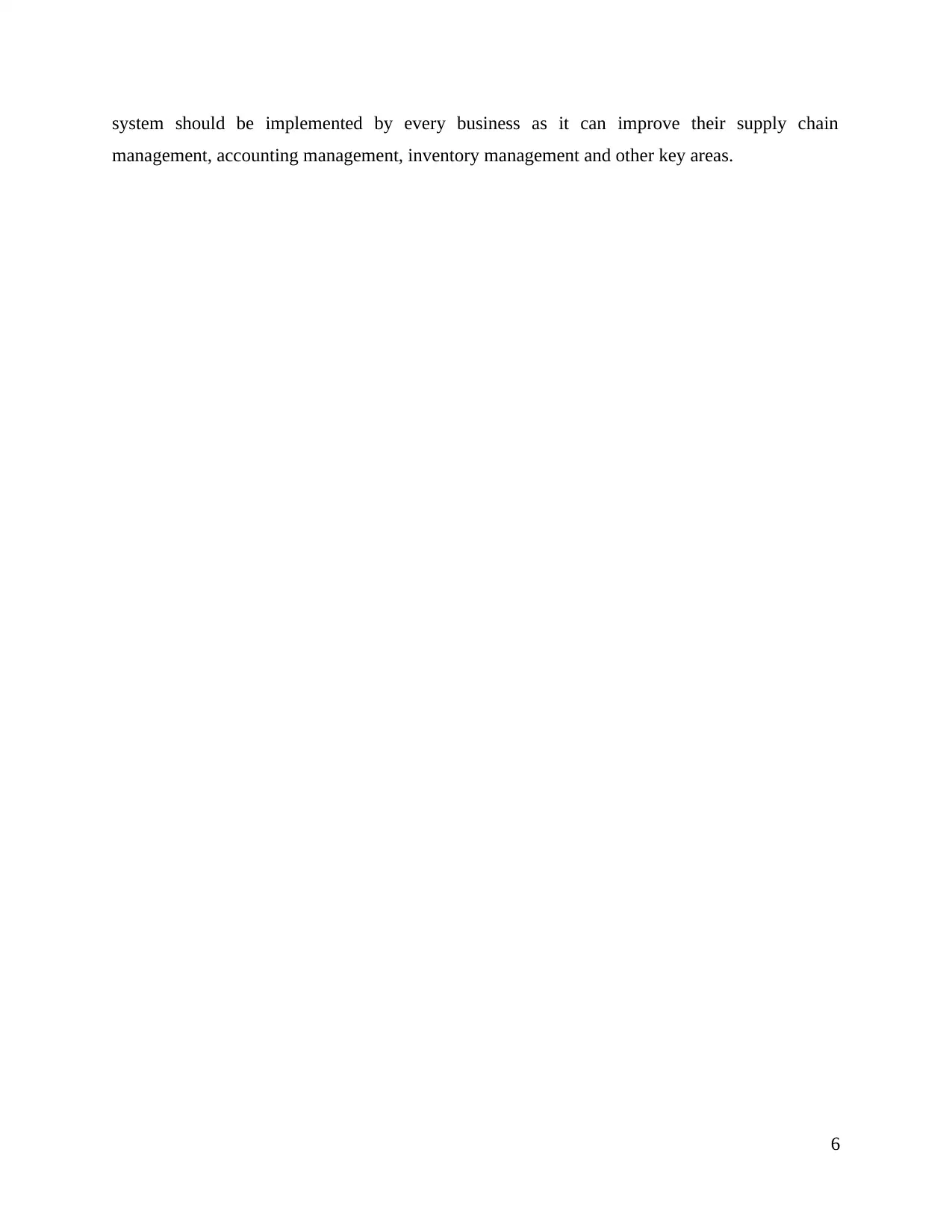
system should be implemented by every business as it can improve their supply chain
management, accounting management, inventory management and other key areas.
6
management, accounting management, inventory management and other key areas.
6
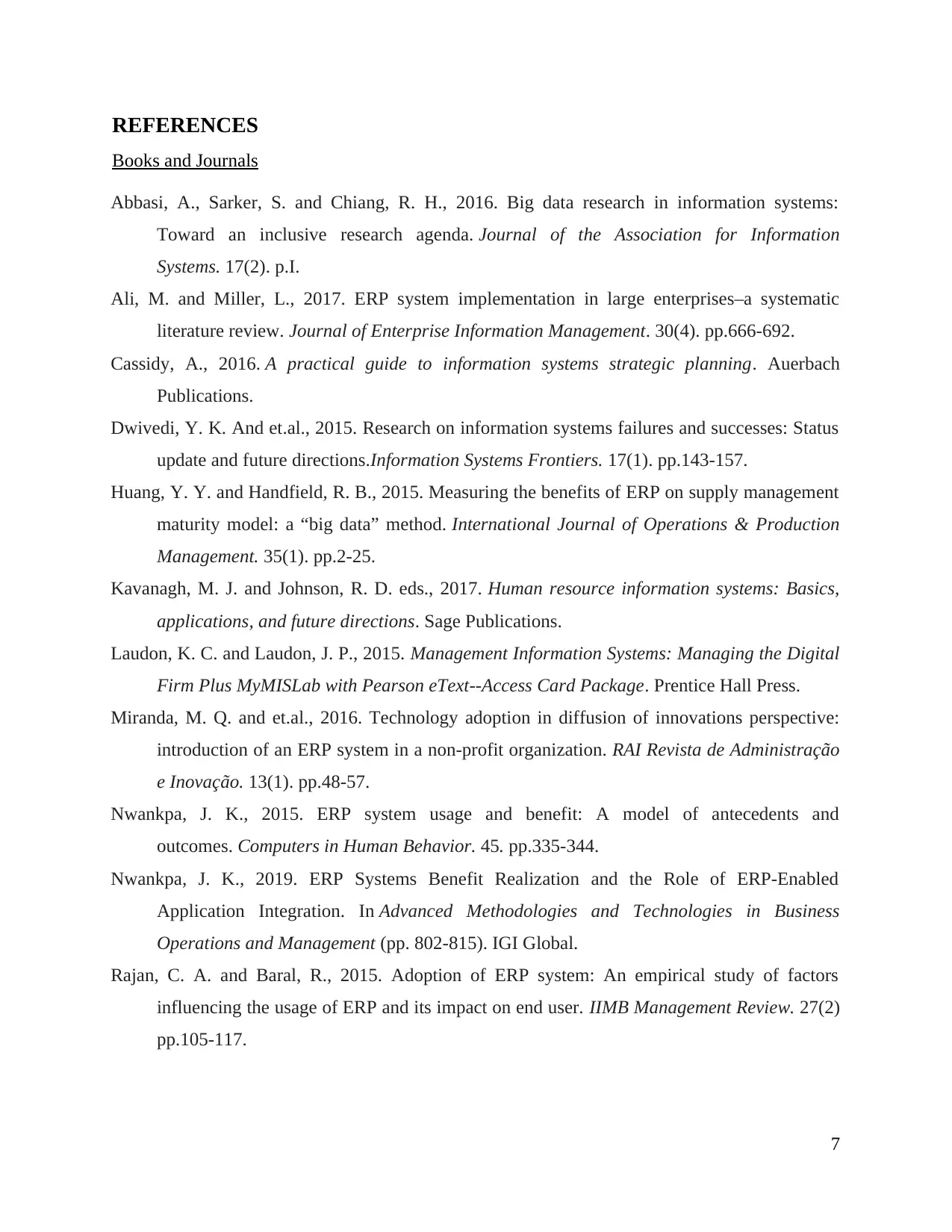
REFERENCES
Books and Journals
Abbasi, A., Sarker, S. and Chiang, R. H., 2016. Big data research in information systems:
Toward an inclusive research agenda. Journal of the Association for Information
Systems. 17(2). p.I.
Ali, M. and Miller, L., 2017. ERP system implementation in large enterprises–a systematic
literature review. Journal of Enterprise Information Management. 30(4). pp.666-692.
Cassidy, A., 2016. A practical guide to information systems strategic planning. Auerbach
Publications.
Dwivedi, Y. K. And et.al., 2015. Research on information systems failures and successes: Status
update and future directions.Information Systems Frontiers. 17(1). pp.143-157.
Huang, Y. Y. and Handfield, R. B., 2015. Measuring the benefits of ERP on supply management
maturity model: a “big data” method. International Journal of Operations & Production
Management. 35(1). pp.2-25.
Kavanagh, M. J. and Johnson, R. D. eds., 2017. Human resource information systems: Basics,
applications, and future directions. Sage Publications.
Laudon, K. C. and Laudon, J. P., 2015. Management Information Systems: Managing the Digital
Firm Plus MyMISLab with Pearson eText--Access Card Package. Prentice Hall Press.
Miranda, M. Q. and et.al., 2016. Technology adoption in diffusion of innovations perspective:
introduction of an ERP system in a non-profit organization. RAI Revista de Administração
e Inovação. 13(1). pp.48-57.
Nwankpa, J. K., 2015. ERP system usage and benefit: A model of antecedents and
outcomes. Computers in Human Behavior. 45. pp.335-344.
Nwankpa, J. K., 2019. ERP Systems Benefit Realization and the Role of ERP-Enabled
Application Integration. In Advanced Methodologies and Technologies in Business
Operations and Management (pp. 802-815). IGI Global.
Rajan, C. A. and Baral, R., 2015. Adoption of ERP system: An empirical study of factors
influencing the usage of ERP and its impact on end user. IIMB Management Review. 27(2)
pp.105-117.
7
Books and Journals
Abbasi, A., Sarker, S. and Chiang, R. H., 2016. Big data research in information systems:
Toward an inclusive research agenda. Journal of the Association for Information
Systems. 17(2). p.I.
Ali, M. and Miller, L., 2017. ERP system implementation in large enterprises–a systematic
literature review. Journal of Enterprise Information Management. 30(4). pp.666-692.
Cassidy, A., 2016. A practical guide to information systems strategic planning. Auerbach
Publications.
Dwivedi, Y. K. And et.al., 2015. Research on information systems failures and successes: Status
update and future directions.Information Systems Frontiers. 17(1). pp.143-157.
Huang, Y. Y. and Handfield, R. B., 2015. Measuring the benefits of ERP on supply management
maturity model: a “big data” method. International Journal of Operations & Production
Management. 35(1). pp.2-25.
Kavanagh, M. J. and Johnson, R. D. eds., 2017. Human resource information systems: Basics,
applications, and future directions. Sage Publications.
Laudon, K. C. and Laudon, J. P., 2015. Management Information Systems: Managing the Digital
Firm Plus MyMISLab with Pearson eText--Access Card Package. Prentice Hall Press.
Miranda, M. Q. and et.al., 2016. Technology adoption in diffusion of innovations perspective:
introduction of an ERP system in a non-profit organization. RAI Revista de Administração
e Inovação. 13(1). pp.48-57.
Nwankpa, J. K., 2015. ERP system usage and benefit: A model of antecedents and
outcomes. Computers in Human Behavior. 45. pp.335-344.
Nwankpa, J. K., 2019. ERP Systems Benefit Realization and the Role of ERP-Enabled
Application Integration. In Advanced Methodologies and Technologies in Business
Operations and Management (pp. 802-815). IGI Global.
Rajan, C. A. and Baral, R., 2015. Adoption of ERP system: An empirical study of factors
influencing the usage of ERP and its impact on end user. IIMB Management Review. 27(2)
pp.105-117.
7
⊘ This is a preview!⊘
Do you want full access?
Subscribe today to unlock all pages.

Trusted by 1+ million students worldwide
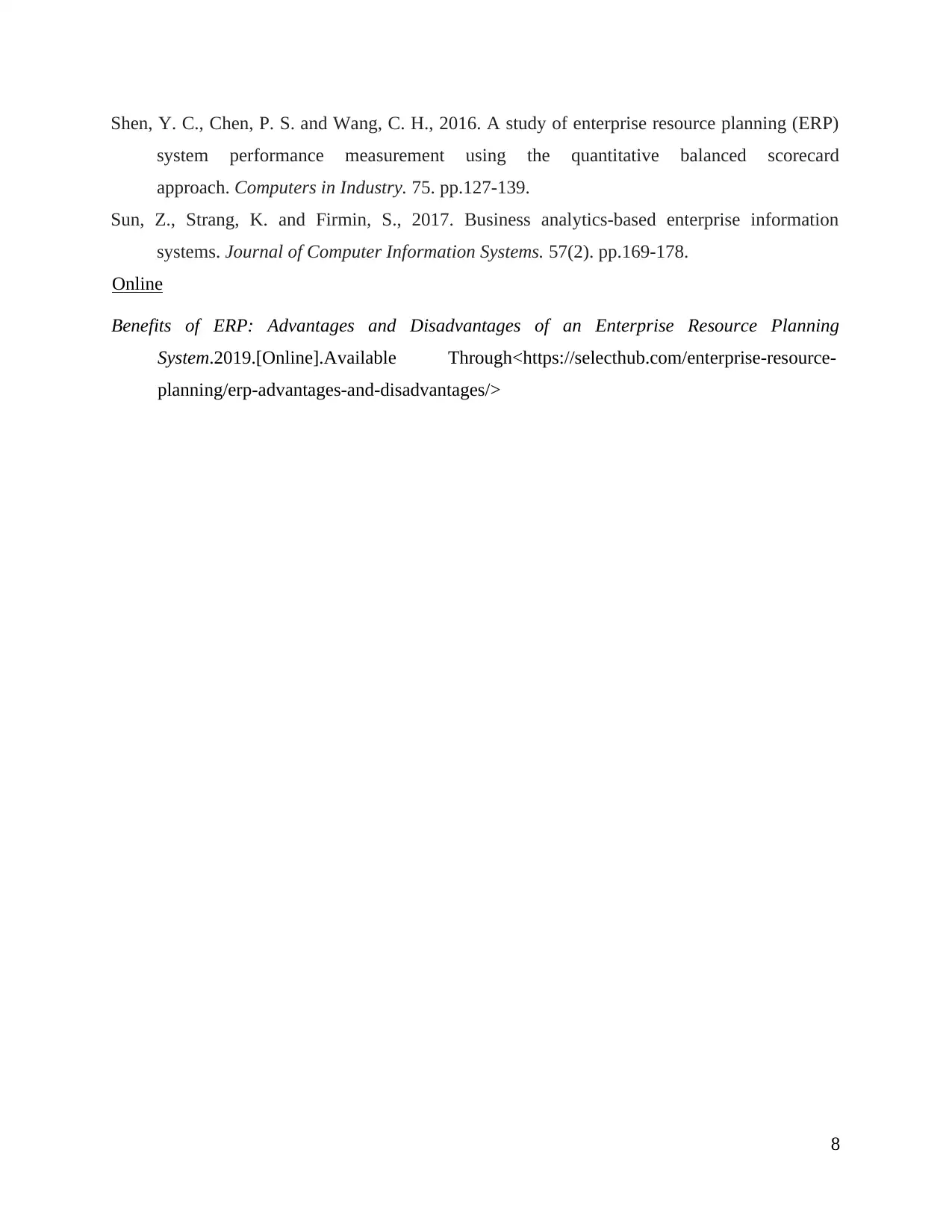
Shen, Y. C., Chen, P. S. and Wang, C. H., 2016. A study of enterprise resource planning (ERP)
system performance measurement using the quantitative balanced scorecard
approach. Computers in Industry. 75. pp.127-139.
Sun, Z., Strang, K. and Firmin, S., 2017. Business analytics-based enterprise information
systems. Journal of Computer Information Systems. 57(2). pp.169-178.
Online
Benefits of ERP: Advantages and Disadvantages of an Enterprise Resource Planning
System.2019.[Online].Available Through<https://selecthub.com/enterprise-resource-
planning/erp-advantages-and-disadvantages/>
8
system performance measurement using the quantitative balanced scorecard
approach. Computers in Industry. 75. pp.127-139.
Sun, Z., Strang, K. and Firmin, S., 2017. Business analytics-based enterprise information
systems. Journal of Computer Information Systems. 57(2). pp.169-178.
Online
Benefits of ERP: Advantages and Disadvantages of an Enterprise Resource Planning
System.2019.[Online].Available Through<https://selecthub.com/enterprise-resource-
planning/erp-advantages-and-disadvantages/>
8
1 out of 10
Related Documents
Your All-in-One AI-Powered Toolkit for Academic Success.
+13062052269
info@desklib.com
Available 24*7 on WhatsApp / Email
![[object Object]](/_next/static/media/star-bottom.7253800d.svg)
Unlock your academic potential
Copyright © 2020–2025 A2Z Services. All Rights Reserved. Developed and managed by ZUCOL.





